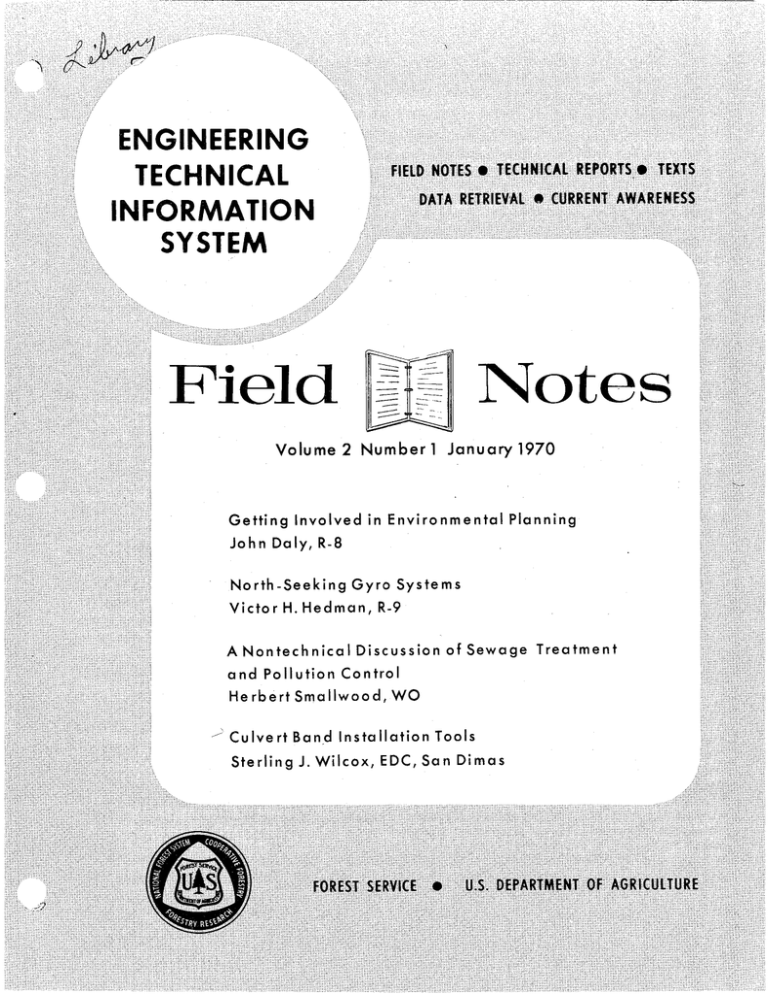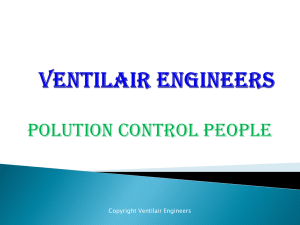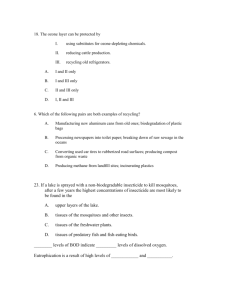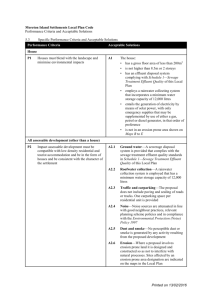Notes Field INFORMATION ENGINEERING
advertisement

ENGINEERING TECHNICAL FIELD INFORMATION TECHNICAL NOTES DATA RETRIEVAL REPORTS. TEXTS 0 CURRENT AWARENESS SYSTEM Notes Field Volume 2 Number Getting Involved John in 1 January 1970 Environmental Planning Daly R-8 North-Seeking Gyro Systems Victor Hedman H. A Nontechnical and Pollution Herbert S ýa Discussion of Sewage Treatment Control Smallwood WO Culvert Band Sterling R-9 J. Installation Wilcox FOREST Tools EDC San Dimas SERVICE U.S. DEPARTMENT OF AGRICULTURE ENGINEERING FIELD NOTES This publication is a monthly newsletter published ideas among Forest Service personnel. The is publication not intended material in the publication be exclusive to Engineering information and However for engineers. and engineering technicians engineers all exchange to because of the type of read each monthly should issue. The publication is distributed from the Washington Office directly to and Research Offices. Center Station Area Laboratory Adequate to provide all who wish a personal If copy. you are not now receiving would like one number the ask your Office of copies sent to issues are also available It is intended Service Field that the Manager your from material Use form 7100-60 Washington the Regional Information or the office. all Forest Regional are printed a personal copy and copies Coordinator to increase purpose. Copies of back and can be ordered on form 7100-60. Office for this Field Notes be primarily written and used by Forest material from other publications may be used. the in Engineers however accom-modate Note material should always be informative and cannot contain mandatory instructions The length of an article may vary from several sentences to several typewritten Material need not-be typed neatly written or printed is acceptable or edited before pages. Field or policy. being This will be done submitted to the Washington Office. our format and allowable space. Each Region has an Information Coordinator to and material for publication. whom The Coordinators are Kenneth R-2 Marshall R-3 Dan Roper R-6 R-8 R-9 Fleet R-10 R-4 R-5 Fox Stanton Chuck WO Paletti the Washington field personnel R-1 Yeager in Don should Office to submit both questions Loff Bailey David Jones Rollie Gerald Schauwecker Norman Sears DISCLAIMER Information contained in this report has been developed for the guidance of employees of the its contractors and its cooperating Department of Agriculture - Forest Service Federal and State agencies. The Department of Agriculture assumes no responsibility for the interpretation or use of this information by other than its own employees. U. S. The use the of reader. trade Such endorsement be suitable. or firm or corporation names use does not constitute approval of any product an is for the official or service information and convenience to of conclusion recommendation the exclusion of others which may evaluation F GETTING INVOLVED by John H. Daly R-8 The of our quality L E I IN D N 0 T E S ENVIRONMENTAL PLANNING environment has come more and more under Pressure from a more informed public has led public scrutiny. the extensive use of the design team concept in the diversified and extensive engineering problems. With the this idea in concept mind of an ideal the R-8 Division design team. of solutions of to many Engineering developed an endeavor They envisioned in the Forest Service. disciplines encompassing many held to a true A 4-day seminar was inter-disciplinary approach promote toward creating and projecting the design team concept in the Forest of the various informa-tion Service. Participants architect hydrologist -- other than biologist and -- engineers ranged from forester soil scientist to public specialist. The main purpose of the seminar was to bring these varied disciplines of each and capabilities together create an awareness of the functions them planning problems and challenges of environmental in the and together analysis design team concept participate field problems. and solution of two existing environmental motivate and to the the dis-cussion seminar was a new approach to planning and guest lecturers provided 6 hours of informative and thought-provoking on diverse aspects of ecology pollution and other factors These guest lecturers were as varied in our environment. affecting The theme of this backgrounds career The guest lecturers as were the Forest Service participants. were Eugene P. Odum -- Director Institute of Ecology University Georgia a delegate to the first Atoms for Peace Conference and Georgias Scientist of the Year in 1968 considered by many as one of the worlds foremost ecologists. Dr. of out-standing Jr. -- Professor of Civil Engineering William W. Eckenfelder Environmental Health Engineering University of Texas Dr. in consultant and field and author of over treatment of wastes. researcher 100 papers in the sanitary engineering and nine books on the biological Frome Mr. Michael One of the countrys leading authoris on conservation winner of the Thomas Wolfe Memorial Award and columnist for the American Forests and Field and -- travel and Stream magazines. Mr. Frome recently Orville L. Freeman a book entitled The co-authoried with National Forests of America. Mr. William Moorehead R. Kidd and president of Florida. Mr. Kidd has -- Consulting engineer Engineering Company Ocala --all capa-bilities been responsible for several major recreational projects in Florida Under former including the redevelopment of Rainbow Springs. Florida Governor Farris Bryant Mr. Kidd served as Administra-tive Assistant responsible recreational programs for the for the development State Many Forest Service participants presented ranged from road design and waste disposal with the intention how and these capabilities After the lectures brief talks. to an awareness of creating fit into of conservation and of Florida. Subject matter timber management each disciplines of environmental planning. were completed the last phase of the seminar began. Four Participants were grouped into design teams. teams of 10 participants each were established. Two of the teams were made up of engineers only the other two teams consisted of all The environmental attending the meeting. planning problems at the Cradle of Forestry were outlined for the teams and field work was and speeches discip-lines to-pography arranged so that gather each team could existing Forest Service personnel all data each project problem inspect discuss the proposed project with both citizens. After the field exercise visit and and local met separately for approximately 3 hours to discuss and each project and to develop action plans supporting the views groups pro-posed analyze ideas of each group. The last day each design team presented solution. was evident to At this presentation all. The teams composed problem analysis and to all engineering and to the the solution in the scientific its and useful life. 2 of the seminar went about and technical the way common Their technological approach as a base and cost as the problems used engineering sciences Their solution was design-oriented capacity main purpose of only engineers analytical criteria. as size cost problem analysis and one disciplines. and -- pointing out such factors The teams composed proved several things. Their varied backgrounds provided different ideas rational objectives and consideration of different alternatives. These objectives and their alternatives involved decisions not only on what to design but why and social of dissimilar occupations economic ecological and esthetic factors as well. The comparisons between these teams pointed out the need and advantages of the inter-disciplinary approach to the problem-solving process in environmental planning. This broad approach forces the planner and designer how to seek to plan and most out the build -- their design decisions. This seminar was favorable and and then how to not the incorporate maximum solution these answers on into multi-disciplinary de-parted insight The participants gained not only success. but also motivation to use the special problems in these concept solving problems. The participants into a great with a noticeable eagerness Victor H. The involved. Hedman R-9 June 1969 introduced of the get GYRO SYSTEMS NORTH-SEEKING By to the Volume 1 Number North-Seeking a follow-up 2 issue of the Field Notes Eastern Regions plans for actual field use This is Gyro System for surveying. on the project. in-cluded orienta-tion In September 1969 the Eastern Region TK-4 North-Seeking Gyro under initiated the use of the Fennel field conditions on a cadastral survey photogrammetric project in northern Minnesota. Project planning the use of the north-seeking gyro to determine precise control in restoring and establishing land corners from ground pro-ject targets. of the gyro prior to field use indicated that precise testing orientation requirements can be accomplished with this instrument. The unknown to be determined was the performance over the entire Preliminary requiring orientation control from 70 targets. transit-traverse The initial phases from ground of the project permitted a check on gyro orientation targets by comparison with independent control lines. Good results were obtained. 3 offsets from less than 10 percent of the project was completed when occurred in the power source. For reasons unknown the nickel-cadmium battery in a special metal housing burned and Unfortunately disinte-grated a failure sack while being carried to the next target location. new battery a malfunction was detected in the backpack in a After replacement with a performance of the gyro. A preliminaryshop inspection of the gyro by the authorized company and a testing of the power source pointed to an internal gyro The gyro has been returned to the Fennel Company for a complete dealer defect. check. re-scheduled An insufficient the range of number of readings The performance. were made with test on We for next field a the gyro to establish complete project is now season. expect performance results under a variety of conditions. Generally we are well satisfied with the results attained but will be alert to performance failures and the reasons Because promised you end to provide for them. of the until the it with the problem encountered in the June 1969 of the next field gyro our issue of the Field Notes complete season. A NONTECHNICAL DISCUSSION OF SEWAGE TREATMENT POLLUTION CONTROL by Herbert Smallwood Why cant we report will be delayed AND WO kind of sewage treatment and use it at all question is asked so frequently of sanitary engineers merits serious attention. Any direct answer will be inadequate settle on one in-fluences of our that it sites because This will exclude it which are from consideration many vital to an understanding of the of the bordering problem. These may In fact the lack of require considerable study or investigation. data concerning the quantity and quality periods of sewage flow is one of the greatest handicaps we have in designing efficient treatment facilities for the Forest Service. We have hopes of undertaking a project basic to satisfy this need in the near future. considerations affecting the design are exactly the same as though we had all the needed data but they cannot be treated as rigorously. Thus the designer is far from assured that the result meets the objectives in The 4 2 3 4 environ-mental an optimal manner. quality standards effluent 1 designer are economics and Matters which concern quality the Water re-quires influence. Water The maintenance of specified water quality Quality Standards. standards for a stream into which an effluent is being discharged knowledge of the quality and effluent. Aside from practicality a the and match be for the quality of the effluent This is hardly possible. to Since in the there will be a difference cost the stream and of both the quantity the ideal quality of the stream. sources two of the quality would situation the measure-ment arises where question will the resultant characteristics be measured the point must be after complete mixing has occurred Practically If the before a change in characteristics would be significant. made is prior to complete mixing a representative and the results are certain to be misleading. be obtained To this extent the setting of effluent standards is more sample rational and will not and The latter is equitable than the setting of water quality standards. less difficult and puts the responsibility for maintaining the water quality In establishing water quality standards the upon the discharger. estab-lishing agency We saying on water quality is discharges maintain the quality of the writing a performance dont know but is the it the dischargers receiving waters. as specification of multiple effluent effect It is opposed responsibilityto very comparable to the recipe to approach. paradoxical that water quality standards have received so much and yet by the Federal Government and by the various States the selection of an appropriate waste water treatment design to meet the It is attention largely intuitional for all but the larger installations. data and a computational approach are needed to replace intuition. standards Basic is general design considerations previously mentioned there are certain characteristics which can be expected of the effluents of various sewage treatment processes. Lagoons aerobic complete mix Within the sus-pended sus-pended mix lagoons can be expected to yield high from the latter two are easier to remove. those although Extended aeration and contact stabilization can normally remove 85-95 and the percent -- both 5-day biochemical oxygen demand and aerated incomplete solids solids. flows both in the To of these clarifier achieve BOD5 this level of solids removal with our variable processes require careful consideration solids removal of peak flows design. Effluent Quality Factors influencing the quality of the effluent are the The and quality of the influent and the treatment given it. quantity quantity and quality in turn are determined by 5 the kind of use the pro-cess numbers of people and It is necessary that the pattern of use. be established prior to deciding upon the the time ultimate plan of development waste treatment design. The treatment given is determined by the which is a design matter and by the skill or application of the The major portion of the designers objectives skills of the operator. un-skilled can wasted be defeated and the investment if the operator is either to the detriment of the or burdened with other responsibilities operation. plant Adminis-tration the usual Unfortunately terms for plant performance is stated The Federal Water Pollution Control specification removal. of percent in per-formance now defines the criteria secondary treatment or its equivalent BOD5 and suspended solids. Used in this of as 85 percent removal of both sense as a criteria of performance against capability quality it leaves of effluent and it quantity is not define to a removal percent term match As a measure meaningful. is much to be desired As a measure of mentioned. or to since the influent quality on water quality influence meaningless. is Since influent mentioned is not quality must be other design criteria To in relation to treatment flexible to discount sufficiently efficiency its effects. set required detention time help accomplish this most State agencies which is a direct measure of the physical size of the plant at the greatest For the sake of economy we need better criteria. possible period. Economics With the and remaining to be effort to choice assure produce to represents operational foregone There It is that the the installed each it is installation needed optimum cost numbers of sewage large quality total cost interest treatment most important that facilities being we make every represents the most economical of effluent. The economical choice after consideration depreciation land cost of and initial the investment cost of any opportunity. many are making an economic choice of treatment systems. overestimate or underestimate operation and maintenance pitfalls in very easy to As an example earth lagoons are con-struction costs. than holes a in the very low initial When ground. investment. lagoons can be left constructed in this manner as hardly more they represent misconception that after themselves. As a result by operate It to often constructed is a great they Yet for proper maintenance such as load-ing in both operation and are usually neglected continued functioning and seeding fertilizing maintenance. earth lagoons require dike of long rooted plants and protection removal against burrowing animals. They also require removal of bottom growing plants or maintenance of the lining if any operational control according to and volume skimming removal of algae deposits on the 6 banks and sludge mats control of up and dispersal of floating algae midges gnats and flies and occasional control mosquitoes psychoda breaking of algae growth. too narrow a to consider pitfalls include the tendency to undertake of alternatives and the reluctance stage construction. Other economic range consider the case of a highly variable an example of alternatives flow. Possible alternatives may include parallel or multiple-chambered extended aeration plants a convertible extended aeration-contact As stabili-zation unit an aerobic or aerated lagoon or combination of both followed by solids removal an oxidation ditch inclusion of a surge tank and under some circumstances batch operation as opposed to continuous flow. The advantages of stage construction are obvious when it is associated but less apparent advantage with increasing use or development when the needed degree of treatment is unknown. An example of this need frequently occurs when an intuitive design is either proposed by is the problem-atic some degree of or requested by another authority to achieve removal is the need for the nutrient nutrient removal. Usually nutrient contribution nor its in the sense that neither the specific ourselves sources has been evaluated either in relationship to other nutrient amount or impact. Therefore. a design which incorporates nutrient Under these conditions removal without this evaluation is intuitive. the first step of which would not better to adopt a stage approach include the nutrient removal phase. Subsequent monitoring would then of for the second stage. establish the need or the lack it it is be recognized that dollars used in building too much plant too little plant detract from the progress of the overall effort. It must or Another economic aspect is the reduction of either initial investment or maintenance costs through layout and design features which reduce the extent of the facility or the man-hours required for operation or The latter incur additional initial costs which have to be main-tenance. included may in the economic appraisal to determine their actual worth. Most of our concerns with the relationship and the environment have been directed toward between sewage disposal the impact of one upon the other. Once the effluent quality needs have been cared for surely we then have the engineering and architectural ingenuity to prevent the method of disposal from creating an undesirable environment. Environmental Influences Engineers generally regard their productions somewhat paternally. Such paternalism should extend to insistence upon appropriate settings to make external presentations in the case of treatment facilities them compatible with their surroundings. This is simple salesmanship. and 7 Another aspect of the relationship however is the impact of the environment upon the treatment facility. This may have considerable economic as well as esthetic importance. Environmental factors may eliminate some will influence the alternatives for treatment and certainly These particular design which is undertaken. of the factors include soil geology and topography wind direction strength and duration sunlight and temperature water table characteristics surface drainage ground cover and area development humidity and precipitation. cost-wise One of the fallacies we embrace facility be selected on the basis of economic facility is only one it is appraisal end of a is the notion that only the treatment appraisal. Yet this system within a system. Perhaps are part. truly cost-conscious any will extend to the collection system water system the even a minor If we waste collection and disposal and the development of the area These should all be treated as parts of a single unit for serving people influencing and influenced by the same environment and subject to the same cost considerations. It is not reasonable solid served. develop-ment that physical esthetics arrangement and independent is entirely of cost. upon topography and arrangement of the dependent Thus the dis-posal ex-pected should not be considered and services. separately from the arrangement of its utilities Granted that and adequate sewage collection treatment and are necessary these efforts cannot in themselves be to control water pollution in water-oriented recreation areas. safe The pollutants reaching the water body even from a faulty sewage system may be only a small portion of that contributed by surface runoff from use areas from meadows and pastures by human and animal litter from construction and maintenance and by seasonal run-off We should not be surprised drainage of otherwise stagnant areas. see continued algae bloom after the installation of an expensive sewage system if we have not invoked an area policing program used ditch and area sweeping provided for dispersal of surface stabilized In spite ground surfaces of all this pollution to and drained adjacent land areas. and eutrophication will continue in The only sensible course is to some degree. People mean pollution. establish an effective continuing water monitoring system at every valuable recreation water to measure the progress of our impacts and to devise counter measures to offset 8 them. CULVERT BAND INSTALLATION TOOLS by Sterling J. Wilcox EDC San Dimas methods are presently being used to aid in installing connecting bands on corrugated metal pipe culverts. Asphalt coatings make the bands especially tough to squeeze together in order to In addition to safety hazards skinned insert the bolts for fastening. Several knuckles Two our etc present available devices attention. by the Fowler South The which seem first is called Nebraska to quite work time-consuming. quite well 68776 50 plus freight. S 1 Fes Yi r y have come to manufactured Ban-Squeeze Route 1 Crystal Lake It is Phone 402-494-3555. the Company Manufacturing Sioux City priced at $42. methods are k-1 ý 9 00 wT 7 J connector can be used on various types and sizes of bands. One problem with it is that on coated bands it is difficult to insert the clamp between the angle iron and the corrugations if this area is filled with bituminous material. We welded an additional tooth on the arm which enabled us to use the tool on 18-inch culverts and draw the band tighter. This 707-255-4655. The second device Enterprises P. O. is a smaller tool Box 2612 Napa manufactured by Hatcher California 94558 Phone priced $27. 50 FOB destination. Price includes a culvert spreader tool used to loosen bands when disassembling It is at sections. 10 ý cM i 9b 3. ýA 1r Z r f 4 f IA9 II also be used on various types and sizes of bands. well on bands with angle iron connector brackets. especially It attaches in the bolt holes rather than between the bracket and corrugations as does the Fowler device. This It connector can works Additional from the sources for these of supply EDITORS We have received requests may be available EPITOME for the chart Costs Air Power Requirements for Aerating Sewage printed an article in December 1969 Volume 1 Number 7 and in devices manufacturer. Field Notes. limited WO The number National Engineers the theme the 1970s. is Division of glossy prints Week Engineering This is a is of Engineering has a of this chart. February 22-28 1970 and Environmental Design for good opportunity to prepare displays or Supervisors Office as the case may be. Lets not miss this chance to project to the public the role of the Forest Service Engineer in planning and design within the rural environment. Let for your Regional Office your imagination be your guide 12



